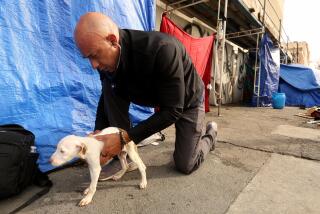Long before City Hall rats, L.A. has struggled with the rise of typhus

Los Angeles officials this month called for an investigation into a vermin infestation at City Hall, after at least one city employee was diagnosed with typhus, a disease spread by rodents.
The rat problem has focused attention on typhus over the last several weeks. But cases of the disease have actually been increasing in California for more than a decade.
Thirteen people in the state were diagnosed with typhus in 2008, compared with 167 last year. More than 95% of the people falling sick in California are in Los Angeles and Orange counties, according to state health data.
Los Angeles City Council President Herb Wesson says he wants to examine the real cause of the typhus cases. On Friday, a giant inflatable rat loomed outside the building while officials inside discussed the vermin issue.
Murine typhus, also known as endemic typhus, typically causes flu-like symptoms, but can in rare cases be fatal. It is not to be confused with typhoid fever, a food-borne illness that is rarely contracted within the United States.
Officials don’t keep count of how many cases of murine typhus there are each year nationwide, but among states that do track the numbers — California, Texas and Hawaii — more people have been falling ill each year, experts say.
Why? Theories abound.
More homelessness
In October, L.A. County officials declared a typhus outbreak in downtown L.A. around skid row. The announcement prompted calls to clean up the streets and find housing for the city’s homeless population, which has burgeoned in recent years.
Typhus is often linked to unsanitary conditions and overcrowding, experts say.
Animals including rats and cats carry the disease in their bodies, though it doesn’t make them ill. Fleas transmit the disease to humans by biting the infected animals and then biting humans, something that could become more common as more people live on the streets.
“In major cities in the U.S., we hear about increasing numbers of encampments and people living in squalor,” said Dr. Jeffrey Klausner, a professor at UCLA’s Fielding School of Public Health. “Those conditions are ideal for increase in vermin like rats.”
Among the 19 people who have been infected as part of the typhus outbreak in downtown Los Angeles, eight were homeless, according to the county health department.
Dr. Stuart Cohen, chief of the division of infectious diseases at UC Davis, pointed out that a large outbreak of hepatitis A in San Diego that killed 20 people was also linked to the homeless population.
“It’s the same kind of thing: Homeless populations increase and the amount of garbage that’s available on the street is increasing — the ability to transmit all this other stuff also increases,” he said.
Climate change
The effects of global warming could also be causing more cases of typhus, said Dr. Jeff Duchin, a spokesman for the Infectious Disease Society of America and an infectious-disease professor at the University of Washington.
Longer and warmer spring and summer seasons are more hospitable to insects and allow them to reproduce more, Duchin said. The trend extends beyond typhus and fleas, he said.
Between 2004 and 2016, the number of cases of diseases caused by mosquito, flea and tick bites tripled nationwide, according to the U.S. Centers for Disease Control and Prevention.
More human interaction with wildlife
Recent outbreaks of typhus in Pasadena and Pomona have been linked not to rats — associated with dirty cities — but with stray cats and opossums. Experts say those outbreaks were the consequence of building homes closer to wilderness.
“As some of these suburban areas encroach upon some of these habitats for opossums and other rodents, the chances of getting flea bites and therefore picking up the infection increases,” Cohen said.
During the last typhus outbreak in Los Angeles County, in 2015, a single opossum captured in a mobile home park in Pomona had 1,087 fleas on it. Three-fifths of the fleas tested from the cats and opossums that were trapped tested positive for typhus.
Los Angeles County health officials would not say which animals are to blame for the downtown outbreak. But many people are pointing to rats.
L.A. Councilman Joe Buscaino tweeted a photo last week of a sign at City Hall with tips on how to avoid attracting rodents. City workers say they’ve seen fleas, rodent droppings, and plants being eaten by the vermin in the building.
Buscaino captioned the photo: “It’s all fun and games until someone gets typhus.”
Increased awareness
The symptoms of typhus, which include body aches, fever and stomach pain, tend to resemble other illnesses. Elizabeth Greenwood, the city employee who fell ill with typhus, was first diagnosed with meningitis.
It’s possible that more people learning about typhus in recent years has made it seem that there are more cases, said Gilbert Kersh, the CDC’s chief of the Rickettsial Zoonoses branch, which focuses on bacterial diseases spread by fleas, lice and ticks.
“Once people are aware that it’s in their area, they might start considering it as the diagnosis, and that can lead to revealing more cases that were there already,” he said.
soumya.karlamangla@latimes.com
Twitter: @skarlamangla
More to Read
Start your day right
Sign up for Essential California for news, features and recommendations from the L.A. Times and beyond in your inbox six days a week.
You may occasionally receive promotional content from the Los Angeles Times.







